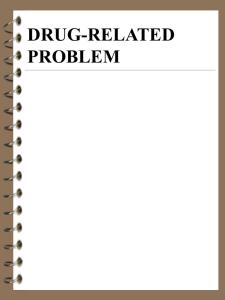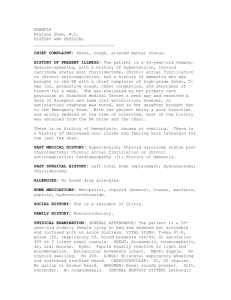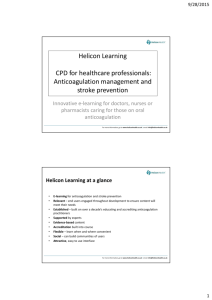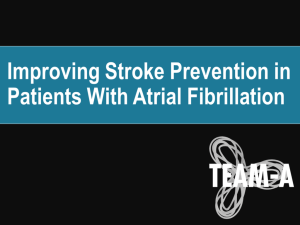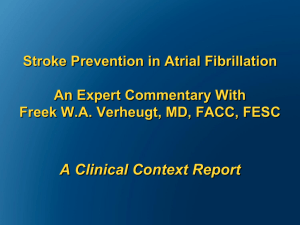Anticoagulation in Atrial Fibrillation Dalia Hawwass PGY2 June 2015
advertisement
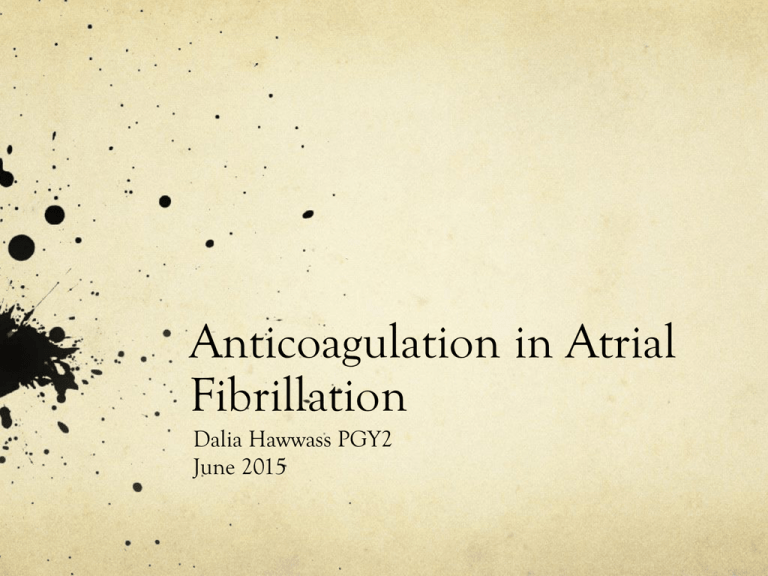
Anticoagulation in Atrial Fibrillation Dalia Hawwass PGY2 June 2015 Objectives Determine when to anticoagulation is needed in patients with non-valvular atrial fibrillation Discussion of risk-based Antithrombotic Therapy (American College of Cardiology recommendations) When to use CHADS2-VaSc or CHADS2 score for stroke risk assessment in non-valvular atrial fibrillation Discussion of Different Anticoagulation Agents (including newer forms of NOAGs) Case Presentation A 65 year old male with PMHx of preserved congestive heart failure (LVEF 40%) and hypertension presents to ED with palpitations and shortness of breath. At baseline, patient has very active lifestyle, including cycling 2-3 times/week. Hospital course notable for newly diagnosed atrial fibrillation secondary to left atrial dilation. Workup was negative for infection, thyroid disease or MI. Renal function is preserved. He was started on rate control with beta blocker. Currently, patient is asymptomatic and SOB resolved. Should this patient be anticoagulated? Anticoagulation in Afib Risk of CVA in nonvalvular Afib is roughly 4.5%/yr Afib is associated with increased risk for heart failure and overall all cause mortality Risk Based Antithrombotic Therapy based on American College of Cardiology recommendations CHADS2-VaSc or CHADS2 score used for nonvalvular Afib for stroke risk assessment CHADS2 Acronym Score CHA2D2-VASc Acronym Score CHF 1 CHF 1 Hypertension 1 Hypertension 1 Age≥ 75 yrs 1 Age≥ 75 yrs 2 Diabetes mellitus 1 Diabetes mellitus 1 Stroke/TIA/T E 2 Stroke/TIA/T E 2 Maximum Score 6 Vascular Disease 1 Age 65-74 1 Female Gender 1 Maximum Score 9 Risk Stratification with CHADS2 Score CHADS2 Acronym Unadjusted ischemic stroke rate (% per year) 0 0.6% 1 3.0% 2 4.2% 3 7.1% 4 11.1% 5 12.5% 6 13.0% Risk Stratification with CHA2DS2VASc Score CHA2DS2-VASc Acroynm Unadjusted ischemic stroke rate (% per year) 0 0.2% 1 0.6% 2 2.2% 3 3.2% 4 4.8% 5 7.2% 6 9.7% 7 11.2% 8 10.8% 9 12.2% Class I Recommendations • Selected Class I Recommendations • In patients with non-valvular AF, calculate CHA2DS2-VASc or CHADS2 • CHADS2-VaSc ≥2, oral anticoagulation recommended For patient with non-valvular AF with prior stroke, TIA or CHADS2-VaSc ≥2, oral anticoagulation recommended with warfarin (Evidence A) or newer agents (Evidence B) Class II Recommendations Class IIa selected recommendations For patients with nonvalvular AF and CHADS2-VaSc=0, reasonable to omit antithrombotic tx (Evidence B) Patients with CHAD2-VaSc 1, can consider anticoagulation or ASA Pt with nonvalvular AF with CHADS2-VaSc ≥2 with end stage CKD (CrCl<15mL/min) or on HD, reasonable to prescribe warfarin (INR 2-3) (Evidence B) Following coronary revascularization in patients with Afib and CHADS2-VaSc ≥2, can use clopdiogrel with oral anticoagulants but without ASA Class III Recommendations: Harm Dabigatran, a direct thrombin inhibitor, should not be used in patients with AF and a mechanical heart valve (evidence B) Direct thrombin inhibitors and factor Xa inhibitors are not recommended in patients with AF and end-stage CKD or on HD Lack of evidence Anticoagulation Agents Aspirin Warfarin (Coumadin) Dabigatraban (Pradaxa) Rivaroxaban (Xarelto) Apixaban (Eliquis) ASA + clopidogrel therapy Aspirin Irreversible inhibitor of COX, reduces prostaglandin and thromboxane A2 ASA shown to be beneficial in both primary and secondary prevention of stroke Benefit to risk ratio in patients at low risk scores of 0 or 1 has not been well studied Recommendations for American College Chest Physicians, for CHADS=0, suggest no therapy rather than antithrombotic therapy If therapy is chosen, suggest ASA 81mg or 325mg If CHADS=1, recommend oral anticoagulation or antiplatelet therapy Plavix + ASA vs Warfarin was compared in the ACTIVE-W trial. Ended early due to inferiority between these two groups in pts with CHADS2 = 2. Plavix + ASA proved to be superior to ASA alone in ACTIVE-A trial. Warfarin (Coumadin) Vitamin K antagonist For with CHADS2-VaSc ≥2 (sometimes also with 1 risk factor) Goal INR 2-3 ARR 2.7% per year, NNT 37 in one year to prevent 1 stroke, NNT of 12 in pts with prior stroke. Risk of stroke in pts with warfarin 1.66% annually Pros: easy to monitor, easily reversible with Vitamin K, FFP, lower cost compared to newer agents, once daily dosing, easy to use in patients with CKD with CrCl <30 mL/min Cons: multiple food-drug/drug-drug interactions; onset action is typically 5-7 days, requires bridging, must monitor INR regularly, skin necrosis Dabigatran (Pradaxa) Direct Thrombin Inhibitor-blocks both free and clot bound thrombin RE-LY Trial established non-inferiority of dabigatran to warfarin showed superior to warfarin in preventing ischemic and hemorrhagic CVAs with reduced risk of major bleeding Increased risk of GI bleeds Dyspepsia most common side effect Dabigatran at 150mg BID CVA risk/yr decreased from 4.5% to 1.1 CHADS=2, Dabigatran 150mg BID rather than adjusted-dose warfarin therapy according to AT9 2012 Chest guidelines Pros: no need for lab monitoring, No known drug-drug/food-drug interactions Con: no reversal agent for major bleeding events, concern for renal impairment, BID dosing, higher costs when compared to coumadin, unknown complete side effect profile, need to use lower dose in pts with CrCl 15-30 mL/min Rivoraxaban (Xarelto) Selective/Reversible direct Factor Xa Inhibitor Prevents conversion of prothrombin to thrombin Rocket-AF trial showed similar major bleeding effect profile overall to warfarin Reduction in intracranial hemorrhage when compared to warfarin Pros: fast onset 2-4 hours, can reduce dosage in renal impairment, daily dosing Cons: no antidote, higher cost when compared to coumadin, unknown complete side effect profile Apixaban (Eliquis) Direct Xa inhibitor ARISTOTLE trial demonstrated superiority over warfarin for major bleeding and overall outcome Pros: can renally dose medication for CKD pts, fast onset 3-4 hours Cons: no antidote, BID dosing, higher cost when compared to coumadin, unknown complete side effect profile Comparison of Agents Case Revisited Patient is a 65 yr old active male with HTN and CHF, with a CHA2DS2-VASc score of 3 (HTN, CHF, age), indicating his unadjusted yearly ischemic stroke risk of 3.2% Class I recommendation to anticoagulate to prevent CVA Patient is healthy and no underlying renal impairment. Discussion with cardiologist to initiate anticoagulation with NOAG instead of coumadin based on active lifestyle Summary CHADS2 and CHA2DS2-Vasc Scores are used for calculation of stroke risk assessment in patients with non-valvular Afib When to initiate anticoagulation based on risk factors Different types of Anticoagulation Agents used in Atrial fibrillation References Uptodate.com: Topics: Anticoagulation in Atrial Fibrillation, Atrial fibrillation overview Uptodate.com: Topics: Acute Management of Atrial Fibrillation Uptodate.com: Topics: Rhythm Control vs Rate Control in Atrial Fibrillation Uptodate.com: Topics: Surgical Management of Atrial Fibrillation January, Craig T. et al. “2014 AHA/ACC/HRS Guideline for Management of Patient with Atrial Fibrillation: Executive Summary." Journal of American College of Cardiology (2014): n. pag. American College Cardiology Foundation. Web. 29 Sept. 2014. http://content.onlinejacc.org/article.aspx?articleid wmshp.org/sg_userfiles/Sarigianis_CE_10172013_handout.pptx King, D, Dickerson, Sack J. Acute Management of Atrial Fibrillation: Part I. Rate and Rhythm Control. Am Fam Physician. 2002 Jul; 66(2): 249-257.


